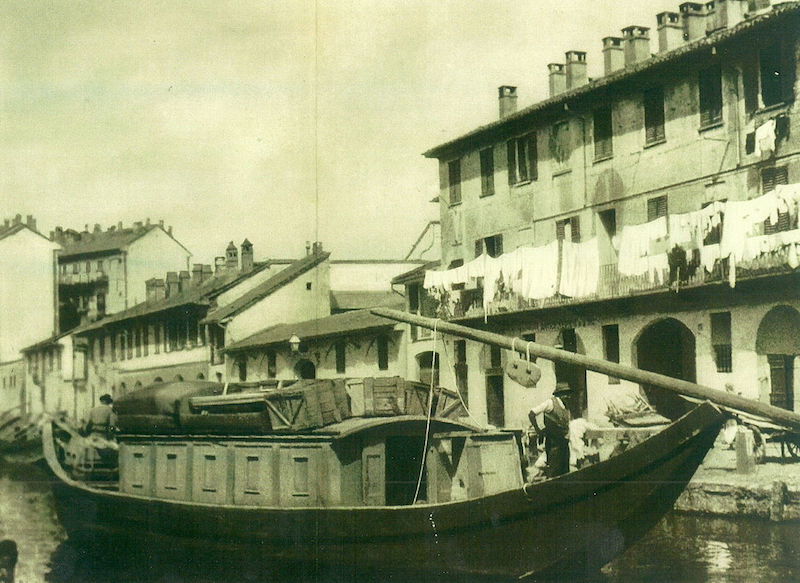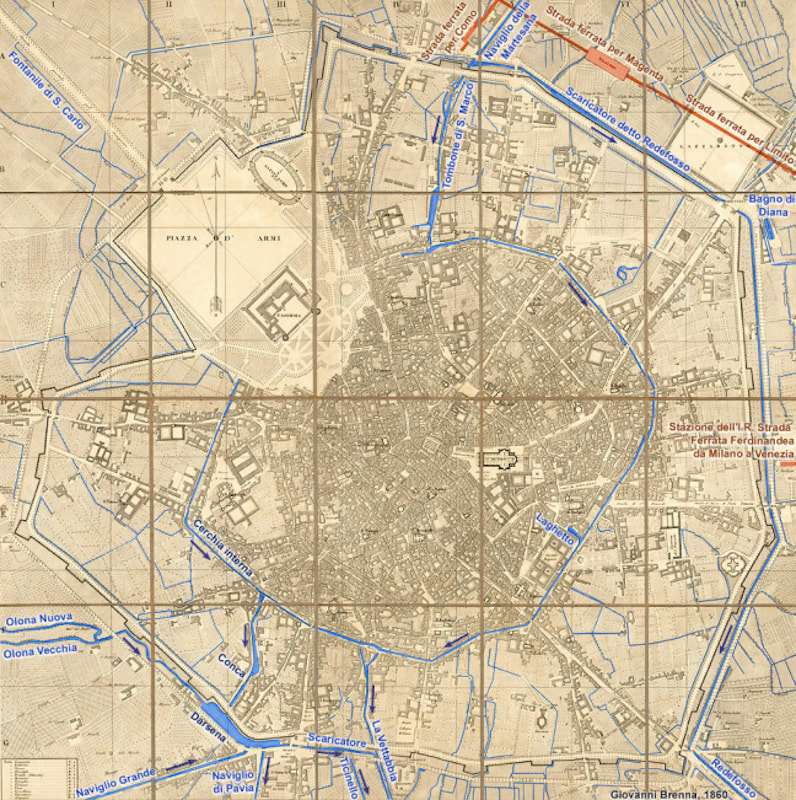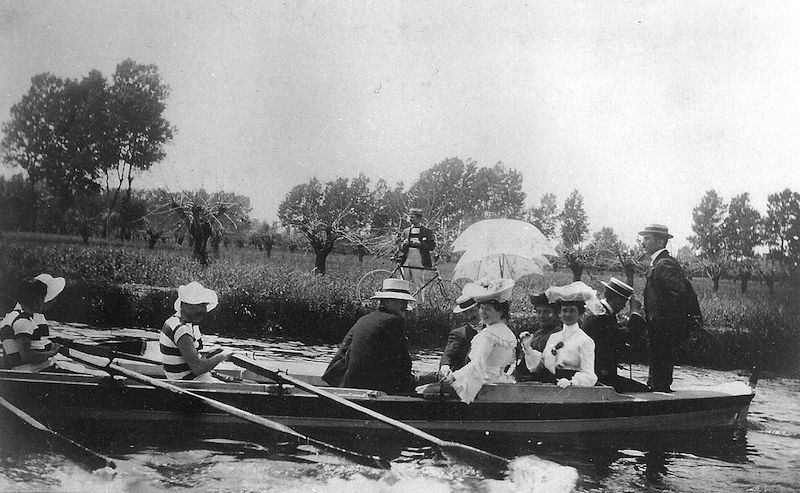|
Have you ever thought of Milan as a city of water? When Daisy first visited Milan in 1889 with her mother and older sister Endemial, the city was surrounded by its 5 working canals. "Bianca made arrangements for our first night supper in Il Centro and suggested we walk along the canals. Milan was a city of tranquil waterways at this time, with barges navigating the picturesque canal-banks. Naviglio means canal in Italian and navigli is the plural and name for the artificial canals of Milan. They were started during Roman times and by the end of the 13th century, water was seen as a way to transport people and objects, like the marble for the Cathedral. Leonardo da Vinci started working on these projects in 1482. This amelioration started the development of a new system of canals that would have made it possible to travel by canal from the Valtellina wine valley in the far North at the border of Switzerland to Milan, had the work been completed. I was lucky to see the City with its waterways intact, as by the 1920’s rail and motor travel saw many of them covered by streets and buildings with just remnants remaining and few signs that Milan had ever been surrounded by water." Read more about Leonardo daVinci's canal designs, why they disappeared and how a growing movement is afoot to uncover them. Milan's canals (navigli) were built in 1157 for defensive and agricultural purposes as a massive ditch dug for deviating the waters of the Ticino river. They served against Frederick Barbarossa (Frederic the First) and his barbaric horde. Today, with its 50-kilometer extension, the Grande stretches to the very heart of Milan, Porta Ticinese, from the city of Varese . Survivors of the the dark ages, invasions and harsh battles, canals became increasingly important for transport, commerce and agriculture. It is often said that Milan was built mostly thanks to Navigli. In fact, the construction of world well-renowned Duomo cathedral was made possible in 1387 because of the marble and stones transported from the Candoglia caves on the waters of the Naviglio Grande. Starting around the 15th century, many local engineers participated in the creation of the water system. Leonardo Da Vinci was only one among them. Leonardo's Navigli At first glance Milan gives the impression of being solely an industrialized urban center. It is seldom regarded as an art destination parallel to cities such as Rome and Florence and thus its rich historical heritage is often overlooked. Exploring the ingenuity of Leonardo Da Vinci’s designs is a gateway into Milan’s rich past. Leonardo Da Vinci was an artist, scientist, and engineer. In 1482, Da Vinci helped devise a plan to improve the navigability of Milan’s Navigli. In 1496, Da Vinci created the miter lock, an ingenious locking system which is still used today. Each side of the locking mechanism is angled at forty-five degrees toward the other and uses the force of the water to control its flow. Da Vinci’s miter lock has withstood the test of time and it is an important contribution to Milan’s Navigli. See below for link to walking itinerary. Commerce flourished thanks to the Grande, which provided an easy, cheap and safe way from Switzerland and Lake Maggiore, and Naviglio di Bereguardo, for all those goods coming from Venice and the Far East. Although this function has slowly decayed in the past few centuries, the canal has been extremely significant for a city with no direct connection to the sea, and greatly contributed to its growth. In Milan, rich people’s garments were washed up by local laundresses in the canals. Today, thoughtful visitors can still have a look at the Laundress Alley, a tiny structure along the Grande which has been preserved in memory of its past. Want to learn more: Take a virtual tour through history at The Navigli Project with lots more about Leonardo and his drawings.
0 Comments
Your comment will be posted after it is approved.
Leave a Reply. |
Some stories that couldn't make the book in full ... but need to be told! Editors welcomed - sign up below.
STORIES
WR HEARST PLANS SONG: DAISY HOT SPRINGS 1882 A WILLIS POLK GIFT THE RLS CONNECTION 1896 EARTHQUAKE TALES FROM COPPA PANDEMIC OF 1889 THE BOMB THAT SHOOK SF MILAN:CITY OF WATER POLK ON THE MAP FEATHERS, FASHION & FLY FISHING RARE AVIATION FILM - WWI 1914-17 1906 SAN FRANCISCO WTF FILES - TECHNOLOGICAL GET ME OUTTA HERE! NO HORSES, NO TENTS, NO $ DAISY IN FRENCH LITERATURE DAISY ON FILM! THE WHITE DEATH THE SYMBOLISM OF FLOWERS POSTE DE SECOURS WWI TRAVEL 1900: LONDON TO PARIS DAISY: REST IN PEACE KEITH'S, DRANE'S & KENTUCKY MOTHER: MISSOURI COMPROMISE Topics
All
|




 RSS Feed
RSS Feed